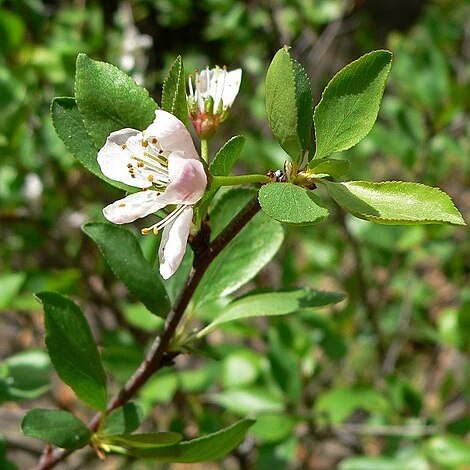Shrubs or trees, often suckering, 10–30(–60) dm, sometimes thorny. Twigs with axillary end buds, glabrous or hairy. Leaves deciduous; petiole 4–18 mm, glabrous or hairy, usually glandular distally, glands 1–3, ?discoid?; blade elliptic, oblong-ovate, or suborbiculate, 2–5(–6.5) × 1.3–3.5(–4.5) cm, base rounded or subcordate, margins singly to doubly serrulate, teeth blunt, glandular, apex usually obtuse to rounded, rarely acute, abaxial surface glabrous or hairy, adaxial glabrous or appressed-hairy. Inflorescences 2–5-flowered, umbellate fascicles. Pedicels 5–15 mm, glabrous or hairy. Flowers blooming at leaf emergence; hypanthium campanulate, 2–3.5 mm, glabrous or hairy externally; sepals broadly spreading to reflexed, obovate, 2.2–4(–5) mm, margins glandular-toothed, sometimes obscurely so, ?sometimes ciliate?, surfaces glabrous or hairy; petals white, oblong-obovate, 5–10 mm; ovaries usually glabrous, rarely hairy. Drupes usually red to reddish purple, sometimes yellow, globose to ellipsoid, 15–25 mm, usually glabrous, rarely puberulent; mesocarps fleshy; stones ovoid, ± flattened.
More
A shrub. It grows 4.5 m tall and spreads 3 m wide. It loses its leaves during the year. The bark is furrowed and grey-brown. It flakes off in scales. The leaves are small and have teeth along the edge. The flowers are white and 18 mm across. They are in small clusters. The fruit are yellow or purple-red.
By streams, on dry hillsides and in open pine forests. Stream banks, dry rocky slopes, chaparral, pine-oak and juniper-oak woodlands; at elevations from 100-1,900 metres.
More
Temperate. It suits hardiness zones 7-10.
The fruit are eaten raw. They are also dried. They are made into preserves, sauces, jellies, syrups and wines. They are also canned.


